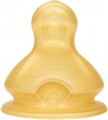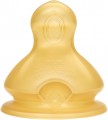Shape
The general shape of a pacifier or pacifier (see "Type").
-
Round. The classic round shape is convenient because the pacifier can be given in any direction. Yes, these models are the cheapest. On the other hand, it is believed that long-term use of a round nipple can lead to a malocclusion.
-
Anatomical. The papilla on the anatomical nipple or pacifier is flattened or elongated, most often it has the shape of an ellipse. It is believed that such products evenly distribute the pressure on the palate, contribute to the formation of a correct bite and prevent the swallowing of air.
-
Orthodontic. A nipple/dummy with a beveled papilla, flattened at the bottom and convex at the top. This form is considered the most correct in terms of anatomy and physiology, but also in terms of convenience for the child (although this moment, of course, is individual). An orthodontic nipple/pacifier takes up minimal space in the mouth, reduces the risk of tooth and palate deformity to almost zero, and contributes to the formation of a correct bite.
Note that when choosing a shape, it is worth considering not only theoretical recommendations, but also the preferences of the baby himself. It happens that an orthopedic or anatomical model that is perfect in shape (theoretically) simply does not like the child, and the simplest round dummy turns out to
...be the most desirable option. That is why all three forms are still relevant.Flow rate
The rate of nutrient flow provided by the nipple (see “Type”), in other words, the rate at which the baby can absorb liquid food through the nipple. This parameter is very important for convenience when feeding: if the speed is too high, the child will choke and swallow air (which is fraught with belching and gas), if feeding is too slow, it can be naughty. However, in general, we can say that a low speed is generally preferable to a high one. So, for newborns, you should definitely use
“slow” models — otherwise the baby simply will not have time to swallow food. As the child grows, it is possible to transfer to teats with larger holes and
higher flow rates ; however, this should not be done by force — it's okay if the baby prefers not to rush when eating and does not want to switch from a “slow” nipple to a “fast” one.
There are models in which the flow rate can be
adjusted ; such nipples are the most versatile and can be used in all age categories, however, they are more expensive than ordinary, “single-speed” ones.
For thick liquids
Teats suitable for use with
thick liquids such as cereals. For this, an appropriate hole size is provided, and such a product is poorly suited for liquid contents — the contents of the bottle will pour out too quickly. This must be taken into account when choosing.

